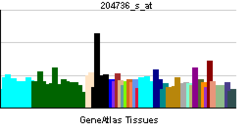- CSPG4
-
Chondroitin sulfate proteoglycan 4 or melanoma-associated chondroitin sulfate proteoglycan (MCSP) is a chondroitin sulfate proteoglycan that in humans is encoded by the CSPG4 gene.[1][2][3]
CSPG4 plays a role in stabilizing cell-substratum interactions during early events of melanoma cell spreading on endothelial basement membranes. It represents an integral membrane chondroitin sulfate proteoglycan expressed by human malignant melanoma cells.[3]
References
- ^ Pluschke G, Vanek M, Evans A, Dittmar T, Schmid P, Itin P, Filardo EJ, Reisfeld RA (Oct 1996). "Molecular cloning of a human melanoma-associated chondroitin sulfate proteoglycan". Proc Natl Acad Sci U S A 93 (18): 9710–5. doi:10.1073/pnas.93.18.9710. PMC 38494. PMID 8790396. http://www.pubmedcentral.nih.gov/articlerender.fcgi?tool=pmcentrez&artid=38494.
- ^ Luo W, Wang X, Kageshita T, Wakasugi S, Karpf AR, Ferrone S (May 2006). "Regulation of high molecular weight-melanoma associated antigen (HMW-MAA) gene expression by promoter DNA methylation in human melanoma cells". Oncogene 25 (20): 2873–84. doi:10.1038/sj.onc.1209319. PMID 16407841.
- ^ a b "Entrez Gene: CSPG4 chondroitin sulfate proteoglycan 4". http://www.ncbi.nlm.nih.gov/sites/entrez?Db=gene&Cmd=ShowDetailView&TermToSearch=1464.
Further reading
- Kirschfink M, Blase L, Engelmann S, Schwartz-Albiez R (1997). "Secreted chondroitin sulfate proteoglycan of human B cell lines binds to the complement protein C1q and inhibits complex formation of C1.". J. Immunol. 158 (3): 1324–31. PMID 9013976.
- Iida J, Meijne AM, Oegema TR, et al. (1998). "A role of chondroitin sulfate glycosaminoglycan binding site in alpha4beta1 integrin-mediated melanoma cell adhesion.". J. Biol. Chem. 273 (10): 5955–62. doi:10.1074/jbc.273.10.5955. PMID 9488735.
- Eisenmann KM, McCarthy JB, Simpson MA, et al. (2000). "Melanoma chondroitin sulphate proteoglycan regulates cell spreading through Cdc42, Ack-1 and p130cas.". Nat. Cell Biol. 1 (8): 507–13. doi:10.1038/70302. PMID 10587647.
- Barritt DS, Pearn MT, Zisch AH, et al. (2000). "The multi-PDZ domain protein MUPP1 is a cytoplasmic ligand for the membrane-spanning proteoglycan NG2.". J. Cell. Biochem. 79 (2): 213–24. doi:10.1002/1097-4644(20001101)79:2<213::AID-JCB50>3.0.CO;2-G. PMID 10967549.
- Iida J, Pei D, Kang T, et al. (2001). "Melanoma chondroitin sulfate proteoglycan regulates matrix metalloproteinase-dependent human melanoma invasion into type I collagen.". J. Biol. Chem. 276 (22): 18786–94. doi:10.1074/jbc.M010053200. PMID 11278606.
- Staub E, Hinzmann B, Rosenthal A (2002). "A novel repeat in the melanoma-associated chondroitin sulfate proteoglycan defines a new protein family.". FEBS Lett. 527 (1-3): 114–8. doi:10.1016/S0014-5793(02)03195-2. PMID 12220645.
- Stegmüller J, Werner H, Nave KA, Trotter J (2003). "The proteoglycan NG2 is complexed with alpha-amino-3-hydroxy-5-methyl-4-isoxazolepropionic acid (AMPA) receptors by the PDZ glutamate receptor interaction protein (GRIP) in glial progenitor cells. Implications for glial-neuronal signaling.". J. Biol. Chem. 278 (6): 3590–8. doi:10.1074/jbc.M210010200. PMID 12458226.
- Strausberg RL, Feingold EA, Grouse LH, et al. (2003). "Generation and initial analysis of more than 15,000 full-length human and mouse cDNA sequences.". Proc. Natl. Acad. Sci. U.S.A. 99 (26): 16899–903. doi:10.1073/pnas.242603899. PMC 139241. PMID 12477932. http://www.pubmedcentral.nih.gov/articlerender.fcgi?tool=pmcentrez&artid=139241.
- Legg J, Jensen UB, Broad S, et al. (2004). "Role of melanoma chondroitin sulphate proteoglycan in patterning stem cells in human interfollicular epidermis.". Development 130 (24): 6049–63. doi:10.1242/dev.00837. PMID 14573520.
- Ghali L, Wong ST, Tidman N, et al. (2004). "Epidermal and hair follicle progenitor cells express melanoma-associated chondroitin sulfate proteoglycan core protein.". J. Invest. Dermatol. 122 (2): 433–42. doi:10.1046/j.0022-202X.2004.22207.x. PMID 15009727.
- Fukushi J, Makagiansar IT, Stallcup WB (2005). "NG2 proteoglycan promotes endothelial cell motility and angiogenesis via engagement of galectin-3 and alpha3beta1 integrin.". Mol. Biol. Cell 15 (8): 3580–90. doi:10.1091/mbc.E04-03-0236. PMC 491820. PMID 15181153. http://www.pubmedcentral.nih.gov/articlerender.fcgi?tool=pmcentrez&artid=491820.
- Yang J, Price MA, Neudauer CL, et al. (2004). "Melanoma chondroitin sulfate proteoglycan enhances FAK and ERK activation by distinct mechanisms.". J. Cell Biol. 165 (6): 881–91. doi:10.1083/jcb.200403174. PMC 2172406. PMID 15210734. http://www.pubmedcentral.nih.gov/articlerender.fcgi?tool=pmcentrez&artid=2172406.
- Colland F, Jacq X, Trouplin V, et al. (2004). "Functional proteomics mapping of a human signaling pathway.". Genome Res. 14 (7): 1324–32. doi:10.1101/gr.2334104. PMC 442148. PMID 15231748. http://www.pubmedcentral.nih.gov/articlerender.fcgi?tool=pmcentrez&artid=442148.
- Suzuki Y, Yamashita R, Shirota M, et al. (2004). "Sequence comparison of human and mouse genes reveals a homologous block structure in the promoter regions.". Genome Res. 14 (9): 1711–8. doi:10.1101/gr.2435604. PMC 515316. PMID 15342556. http://www.pubmedcentral.nih.gov/articlerender.fcgi?tool=pmcentrez&artid=515316.
- Makagiansar IT, Williams S, Dahlin-Huppe K, et al. (2005). "Phosphorylation of NG2 proteoglycan by protein kinase C-alpha regulates polarized membrane distribution and cell motility.". J. Biol. Chem. 279 (53): 55262–70. doi:10.1074/jbc.M411045200. PMID 15504744.
- Petrini S, Tessa A, Stallcup WB, et al. (2006). "Altered expression of the MCSP/NG2 chondroitin sulfate proteoglycan in collagen VI deficiency.". Mol. Cell. Neurosci. 30 (3): 408–17. doi:10.1016/j.mcn.2005.08.005. PMID 16169245.
- Brekke C, Lundervold A, Enger PØ, et al. (2006). "NG2 expression regulates vascular morphology and function in human brain tumours.". Neuroimage 29 (3): 965–76. doi:10.1016/j.neuroimage.2005.08.026. PMID 16253523.
- Liu T, Qian WJ, Gritsenko MA, et al. (2006). "Human plasma N-glycoproteome analysis by immunoaffinity subtraction, hydrazide chemistry, and mass spectrometry.". J. Proteome Res. 4 (6): 2070–80. doi:10.1021/pr0502065. PMC 1850943. PMID 16335952. http://www.pubmedcentral.nih.gov/articlerender.fcgi?tool=pmcentrez&artid=1850943.
Mucoproteins OtherProteoglycan Testican · PerlecanChondroitin sulfate proteoglycans: Aggrecan · Neurocan · Brevican · CD44 · CSPG4 · CSPG5 · Platelet factor 4 · Structural maintenance of chromosomes 3Fibromodulin · Lumican · KeratocanOther Activin and inhibin · ADAM · Alpha 1-antichymotrypsin · Apolipoprotein H · CD70 · Asialoglycoprotein · Avidin · B-cell activating factor · 4-1BB ligand · Cholesterylester transfer protein · Clusterin · Colony-stimulating factor · Hemopexin · Lactoferrin · Membrane glycoproteins · Myelin protein zero · Osteonectin · Protein C · Protein S · Serum amyloid P component · Sialoglycoprotein (CD43, Glycophorin, Glycophorin C) · Thrombopoietin · Thyroglobulin · Thyroxine-binding proteins · Transcortin · Tumor necrosis factor-alpha · Uteroglobin · Vitronectinbiochemical families: prot · nucl · carb (glpr, alco, glys) · lipd (fata/i, phld, strd, gllp, eico) · amac/i · ncbs/i · ttpy/iCategories:- Human proteins
- Chromosome 15 gene stubs
Wikimedia Foundation. 2010.


